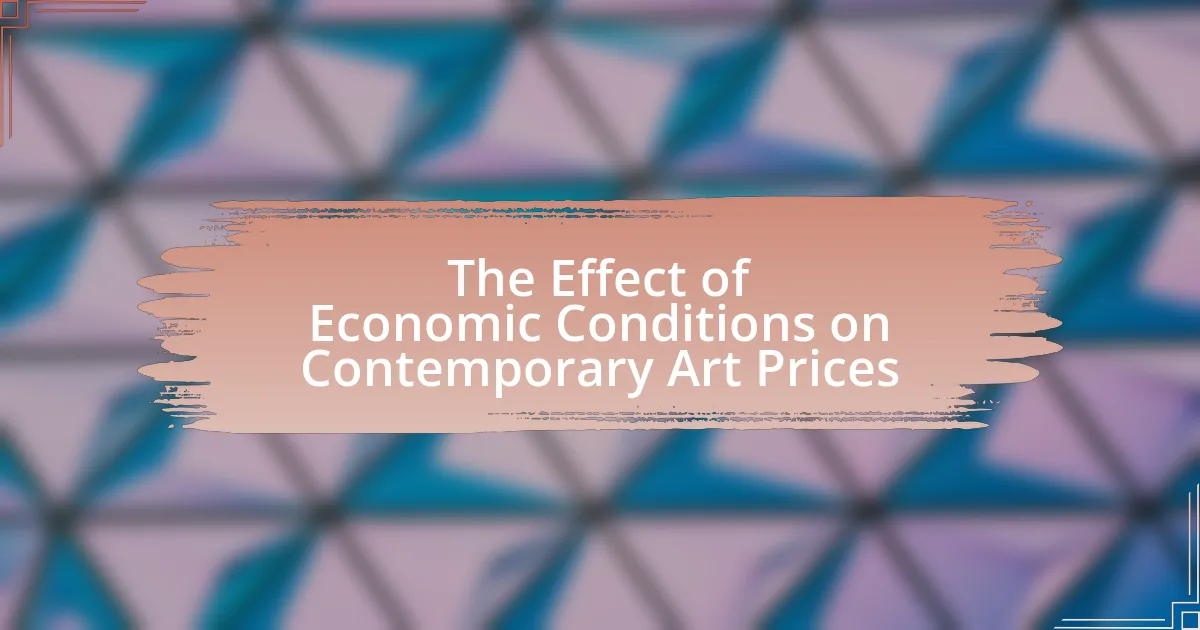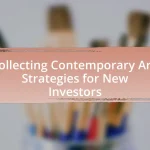The article examines the impact of economic conditions on contemporary art prices, highlighting key factors such as inflation rates, disposable income, and overall economic growth. It discusses how economic indicators influence art market trends, buyer behavior, and the demand for art, particularly during periods of economic expansion or downturns. The analysis includes specific economic indicators relevant to art pricing, the risks investors face in fluctuating climates, and strategies for artists and galleries to navigate economic challenges. Additionally, it explores the long-term effects of economic conditions on art valuations and the correlation between consumer confidence and art sales.
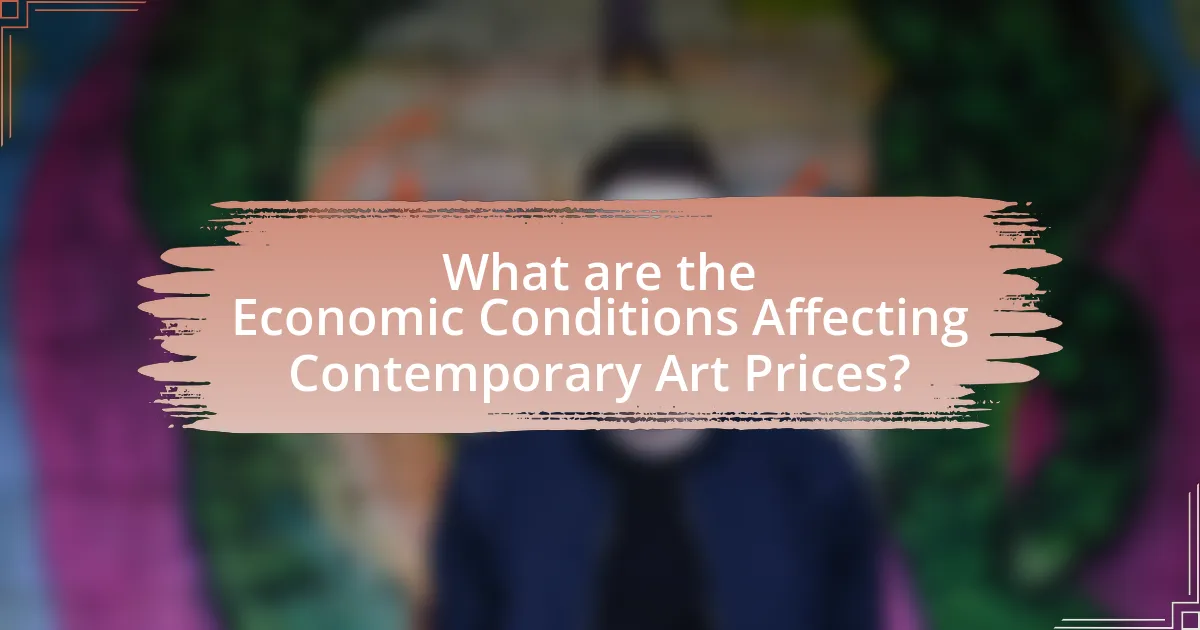
What are the Economic Conditions Affecting Contemporary Art Prices?
Economic conditions affecting contemporary art prices include factors such as inflation rates, disposable income levels, and overall economic growth. Inflation can lead to increased costs for materials and production, which may drive up art prices. Additionally, when disposable income rises, collectors are more likely to invest in art, boosting demand and prices. Conversely, during economic downturns, reduced consumer spending can lead to lower demand and subsequently lower prices for contemporary art. Historical data shows that during the 2008 financial crisis, contemporary art prices fell significantly, illustrating the direct impact of economic conditions on the art market.
How do economic indicators influence art market trends?
Economic indicators significantly influence art market trends by affecting consumer confidence and disposable income. When economic growth is strong, indicators such as GDP growth and low unemployment rates typically lead to increased wealth among collectors, resulting in higher demand for art. For instance, during the economic expansion from 2009 to 2019, the global art market saw a substantial increase in sales, with the Art Basel and UBS Global Art Market Report noting a rise in total sales from $57 billion in 2016 to $67.4 billion in 2019. Conversely, during economic downturns, such as the 2008 financial crisis, art sales plummeted, reflecting decreased consumer spending and investment in luxury items. This correlation between economic health and art market performance underscores how fluctuations in economic indicators directly shape trends in art buying and selling.
What specific economic indicators are most relevant to art prices?
The specific economic indicators most relevant to art prices include GDP growth, inflation rates, disposable income levels, and stock market performance. GDP growth reflects overall economic health, influencing consumer spending on luxury items like art. Inflation rates affect purchasing power, impacting how much buyers are willing to spend. Higher disposable income levels typically correlate with increased art purchases, as wealthier individuals are more likely to invest in art. Additionally, stock market performance can serve as a barometer for wealth and confidence, with rising markets often leading to increased art sales. Historical data shows that during economic booms, art prices tend to rise, while during recessions, they often decline, demonstrating the direct relationship between these indicators and art market dynamics.
How do changes in these indicators impact buyer behavior?
Changes in economic indicators such as unemployment rates, consumer confidence, and inflation directly impact buyer behavior in the contemporary art market. For instance, when unemployment rates rise, disposable income decreases, leading to reduced spending on luxury items like art. Conversely, high consumer confidence typically correlates with increased art purchases, as buyers feel more secure in their financial situations. Additionally, inflation can affect the perceived value of art; if prices rise significantly, buyers may hesitate to invest, fearing that the art may not appreciate in value. Historical data shows that during economic downturns, art sales often decline, while during periods of economic growth, sales tend to increase, illustrating the strong link between economic conditions and buyer behavior in the art market.
Why is understanding economic conditions important for art investors?
Understanding economic conditions is crucial for art investors because these conditions directly influence art market dynamics and pricing. Economic indicators such as GDP growth, inflation rates, and consumer confidence affect disposable income and investment behavior, which in turn impact demand for art. For instance, during economic downturns, art prices often decline as investors prioritize liquidity over luxury assets. Historical data shows that during the 2008 financial crisis, the global art market experienced a significant drop in sales, highlighting the correlation between economic health and art valuations. Thus, art investors must analyze economic trends to make informed decisions and optimize their investment strategies.
What risks do investors face in fluctuating economic climates?
Investors face several risks in fluctuating economic climates, including market volatility, liquidity risk, and changes in consumer demand. Market volatility can lead to significant price fluctuations in assets, making it difficult for investors to predict returns. For instance, during economic downturns, art prices may decline sharply, as seen in the 2008 financial crisis when contemporary art prices fell by an average of 30%. Liquidity risk arises when investors struggle to sell their assets quickly without incurring substantial losses, particularly in niche markets like contemporary art. Additionally, changes in consumer demand can impact art prices; for example, during economic uncertainty, collectors may prioritize essential expenditures over luxury items, leading to decreased demand for art. These factors collectively heighten the risks for investors in fluctuating economic climates.
How can investors leverage economic insights to make informed decisions?
Investors can leverage economic insights by analyzing indicators such as GDP growth, inflation rates, and consumer spending trends to make informed decisions about contemporary art investments. For instance, during periods of economic expansion, disposable income typically increases, leading to higher demand for luxury items, including art. Historical data shows that contemporary art prices tend to rise during economic booms; for example, the Art Market Report by Art Basel and UBS indicated a 6% increase in global art sales in 2021, correlating with economic recovery post-pandemic. By understanding these economic patterns, investors can time their purchases and sales more effectively, maximizing returns on their art investments.
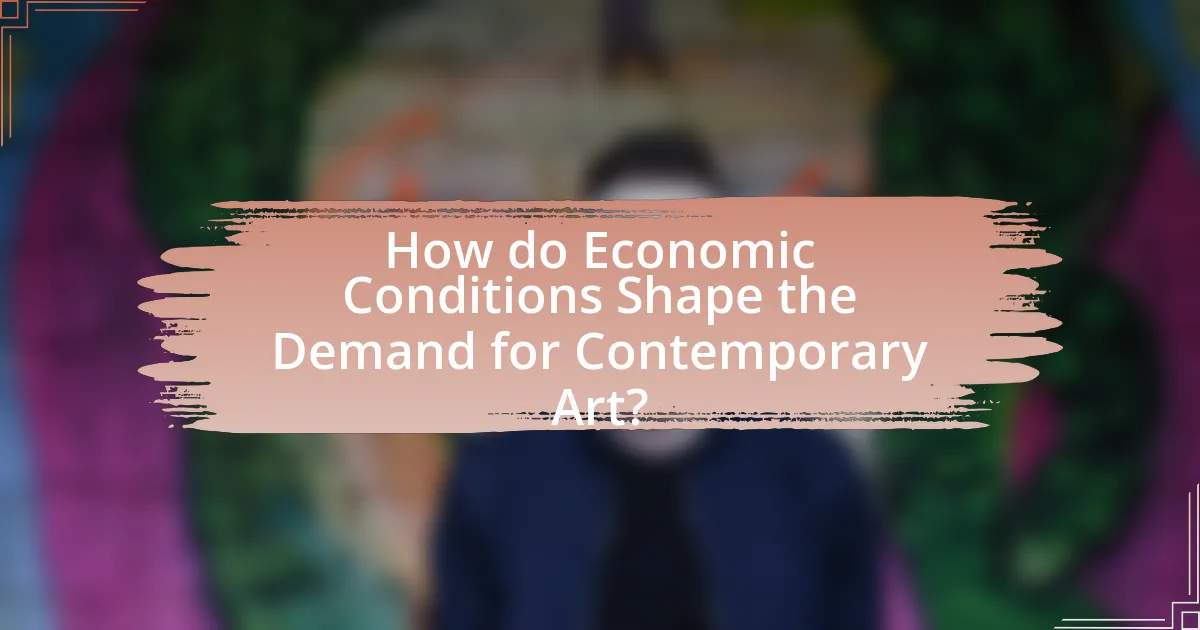
How do Economic Conditions Shape the Demand for Contemporary Art?
Economic conditions significantly influence the demand for contemporary art by affecting disposable income and consumer confidence. During periods of economic growth, individuals and collectors typically experience increased wealth, leading to higher spending on luxury items, including art. For instance, a report from Art Basel and UBS indicated that the global art market reached $67.4 billion in 2018, reflecting strong demand during economic expansion. Conversely, during economic downturns, such as the 2008 financial crisis, art sales plummeted, with auction houses reporting declines in sales volume and value, as collectors prioritized essential expenditures over luxury purchases. Thus, the correlation between economic conditions and art demand is evident, with robust economies fostering higher demand and recessions leading to decreased interest in contemporary art.
What role does consumer confidence play in art purchases?
Consumer confidence significantly influences art purchases, as it directly affects buyers’ willingness to spend on luxury items. When consumer confidence is high, individuals are more likely to invest in art, viewing it as a stable asset or a means of personal expression. Conversely, during periods of low consumer confidence, potential buyers may prioritize essential expenditures over discretionary purchases like art. Research indicates that during economic downturns, art sales often decline, reflecting a direct correlation between consumer sentiment and market activity in the art sector. For instance, a report by Art Basel and UBS in 2021 highlighted that art market sales surged as consumer confidence rebounded post-pandemic, illustrating the impact of economic sentiment on art transactions.
How does consumer spending correlate with art sales?
Consumer spending directly influences art sales, as higher disposable income typically leads to increased purchases of art. When economic conditions improve, consumer confidence rises, resulting in greater willingness to invest in luxury items, including art. For instance, a report by Art Basel and UBS in 2021 indicated that the global art market reached $65.1 billion, reflecting a rebound in consumer spending post-pandemic. This correlation suggests that as consumer spending increases, so does the demand for art, driving up sales and prices in the contemporary art market.
What demographic factors influence demand during economic downturns?
Economic downturns are influenced by several demographic factors that affect demand, including income levels, age distribution, and education. Lower income levels typically lead to reduced discretionary spending, impacting demand for non-essential goods, including contemporary art. For instance, during the 2008 financial crisis, households with lower incomes significantly cut back on luxury purchases, which included art. Age distribution also plays a role; younger consumers may prioritize essential spending over art acquisitions, while older, wealthier collectors may continue to invest despite economic challenges. Additionally, education levels correlate with art appreciation and purchasing power; individuals with higher education often have greater disposable income and a stronger interest in art, which can sustain demand even in downturns.
How do global economic trends affect local art markets?
Global economic trends significantly influence local art markets by affecting disposable income, investment patterns, and consumer confidence. When the global economy is strong, individuals and institutions tend to have more disposable income, leading to increased spending on art. For instance, during periods of economic growth, art sales often rise, as seen in the 2000s when the global economy expanded, resulting in record auction prices and heightened demand for contemporary art. Conversely, during economic downturns, such as the 2008 financial crisis, art markets typically experience declines in sales and prices, as collectors become more cautious and prioritize essential expenditures over luxury items like art. This correlation between global economic conditions and local art markets is evident in various market reports, which consistently show that art prices fluctuate in tandem with broader economic indicators.
What impact do international trade policies have on art prices?
International trade policies significantly influence art prices by affecting the flow of art across borders, import/export tariffs, and market accessibility. For instance, when countries impose high tariffs on imported art, it can lead to increased prices for collectors and galleries, thereby reducing demand. Conversely, trade agreements that lower tariffs can enhance market access, potentially increasing art prices due to heightened competition and availability. Historical data shows that during periods of favorable trade agreements, such as the North American Free Trade Agreement (NAFTA), there was a notable increase in art transactions between the U.S., Canada, and Mexico, reflecting a direct correlation between trade policies and art market dynamics.
How do currency fluctuations influence art transactions?
Currency fluctuations significantly influence art transactions by affecting the purchasing power of buyers and the pricing strategies of sellers. When a currency strengthens, buyers in that currency can afford higher-priced artworks, potentially driving up demand and prices in the art market. Conversely, when a currency weakens, buyers may find art more expensive, leading to decreased demand and lower prices. For instance, the 2015 devaluation of the Chinese yuan resulted in a notable decline in art purchases from Chinese collectors, illustrating how currency changes can directly impact transaction volumes and pricing dynamics in the art market.
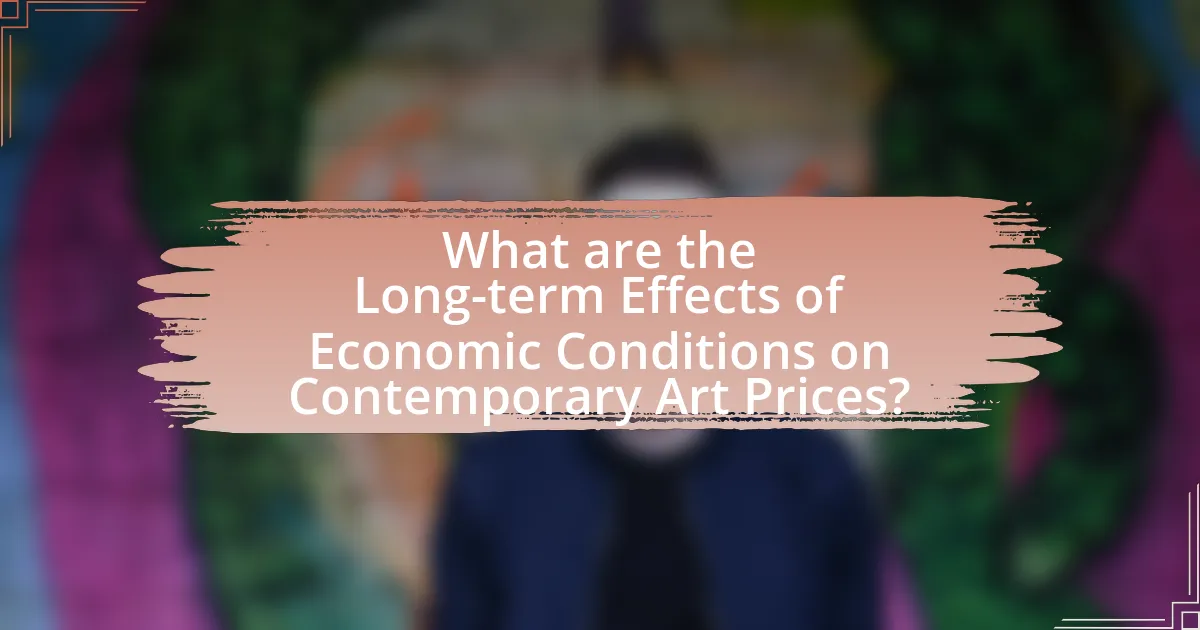
What are the Long-term Effects of Economic Conditions on Contemporary Art Prices?
Long-term economic conditions significantly influence contemporary art prices by affecting demand, investment behavior, and market stability. During periods of economic growth, disposable income increases, leading to higher demand for art, which can drive prices up. Conversely, during economic downturns, reduced consumer spending often results in decreased demand, causing prices to stagnate or decline. Historical data shows that during the 2008 financial crisis, contemporary art prices fell by approximately 30% as collectors became more risk-averse and focused on liquidity. Additionally, inflation and interest rates can impact the art market; for instance, high inflation may lead investors to seek tangible assets like art, potentially increasing prices. Thus, the interplay between economic conditions and contemporary art prices is evident through historical trends and market responses.
How do recessions historically affect art valuations?
Recessions historically lead to a decline in art valuations due to decreased disposable income and reduced consumer confidence. During economic downturns, collectors and investors often prioritize essential expenditures over luxury items, including art, resulting in lower demand and prices. For instance, the 2008 financial crisis saw a significant drop in art sales, with auction houses reporting declines of up to 30% in total sales. Additionally, a study by the Art Market Research in 2020 indicated that art prices tend to recover slowly after recessions, reflecting the long-term impact of economic conditions on the art market.
What patterns emerge in art prices during economic recovery phases?
Art prices typically experience an upward trend during economic recovery phases. This increase is often driven by heightened consumer confidence and disposable income, which leads to greater investment in luxury items, including art. Historical data from the art market indicates that following the 2008 financial crisis, art prices rebounded significantly, with the global art market growing by approximately 7% annually from 2010 to 2019, as reported by Art Basel and UBS. Additionally, auction houses like Sotheby’s and Christie’s have noted increased bidding activity and higher sale prices for contemporary art during periods of economic recovery, reflecting a renewed interest and willingness to invest in art assets.
How do collectors’ strategies change in response to economic shifts?
Collectors’ strategies shift significantly in response to economic changes, often adapting their purchasing behavior based on market conditions. During economic downturns, collectors tend to become more cautious, prioritizing established artists and artworks with proven value to mitigate risk. For instance, a study by Art Basel and UBS in 2021 indicated that 60% of collectors focused on acquiring works from blue-chip artists during economic uncertainty, reflecting a preference for stability over speculative investments. Conversely, in periods of economic growth, collectors may diversify their portfolios by exploring emerging artists and new trends, as they feel more confident in their financial positions. This adaptability illustrates how economic conditions directly influence collectors’ decision-making processes in the contemporary art market.
What strategies can artists and galleries adopt to navigate economic challenges?
Artists and galleries can adopt several strategies to navigate economic challenges, including diversifying revenue streams, leveraging online platforms, and engaging in community collaborations. Diversifying revenue streams allows artists to reduce reliance on traditional sales by exploring alternative income sources such as workshops, commissions, or merchandise. For instance, a study by the National Endowment for the Arts found that artists who diversified their income were more resilient during economic downturns.
Leveraging online platforms enables galleries and artists to reach a broader audience, facilitating sales through virtual exhibitions and social media marketing. According to a report by Art Basel and UBS, online sales in the art market reached $12.4 billion in 2021, highlighting the importance of digital engagement.
Engaging in community collaborations can enhance visibility and foster support networks, allowing artists and galleries to share resources and audiences. Collaborative projects often attract funding and sponsorship opportunities, which can be crucial during economic hardships. These strategies collectively empower artists and galleries to adapt and thrive despite economic fluctuations.
How can pricing strategies be adjusted in response to economic conditions?
Pricing strategies can be adjusted in response to economic conditions by implementing dynamic pricing, value-based pricing, and cost-plus pricing. Dynamic pricing allows businesses to change prices based on market demand and economic indicators, such as inflation rates or consumer spending trends. For instance, during economic downturns, companies may lower prices to stimulate demand, while in a booming economy, they might increase prices to maximize profits. Value-based pricing focuses on setting prices based on the perceived value to the customer, which can shift with economic conditions; for example, luxury items may see price reductions during recessions as consumers prioritize essential goods. Cost-plus pricing involves adjusting prices based on production costs, which can fluctuate due to changes in material costs or labor rates during different economic phases. Historical data shows that during the 2008 financial crisis, many art galleries reduced prices by up to 30% to maintain sales, illustrating how economic conditions directly influence pricing strategies in the contemporary art market.
What marketing approaches are effective during economic downturns?
Effective marketing approaches during economic downturns include emphasizing value, focusing on customer retention, and utilizing digital marketing strategies. During economic challenges, consumers prioritize essential purchases and seek value for their money, making it crucial for businesses to highlight the benefits and cost-effectiveness of their products or services. Additionally, retaining existing customers becomes more important than acquiring new ones; therefore, loyalty programs and personalized communication can enhance customer relationships. Digital marketing, particularly through social media and email campaigns, allows for targeted outreach and cost-effective advertising, enabling businesses to maintain visibility and engagement with their audience. Historical data shows that companies that adapt their marketing strategies during downturns often emerge stronger; for instance, during the 2008 financial crisis, brands that maintained or increased their marketing spend saw a significant return on investment in the following years.
What practical tips can art investors use to adapt to changing economic conditions?
Art investors can adapt to changing economic conditions by diversifying their portfolios, focusing on emerging artists, and staying informed about market trends. Diversification reduces risk; for instance, investing in a mix of established and emerging artists can balance potential losses during economic downturns. Focusing on emerging artists allows investors to capitalize on lower entry prices and potential future appreciation, as seen in the rise of artists like Amoako Boafo, whose works gained significant value during economic fluctuations. Staying informed about market trends through art fairs, auctions, and reports from organizations like Art Basel can help investors make timely decisions, as the contemporary art market often reflects broader economic indicators.
